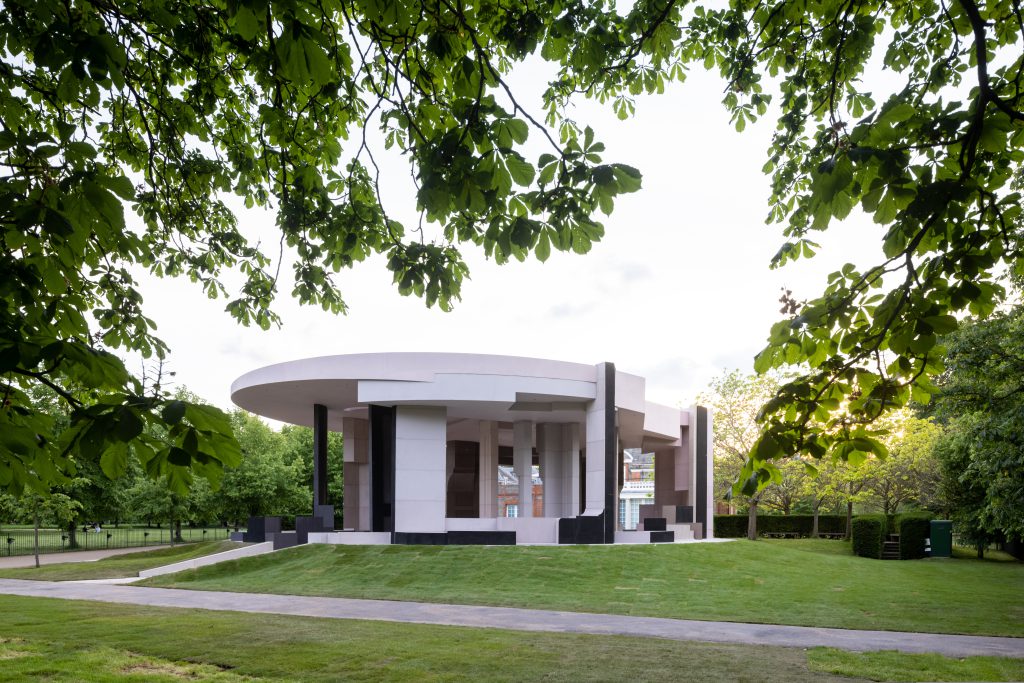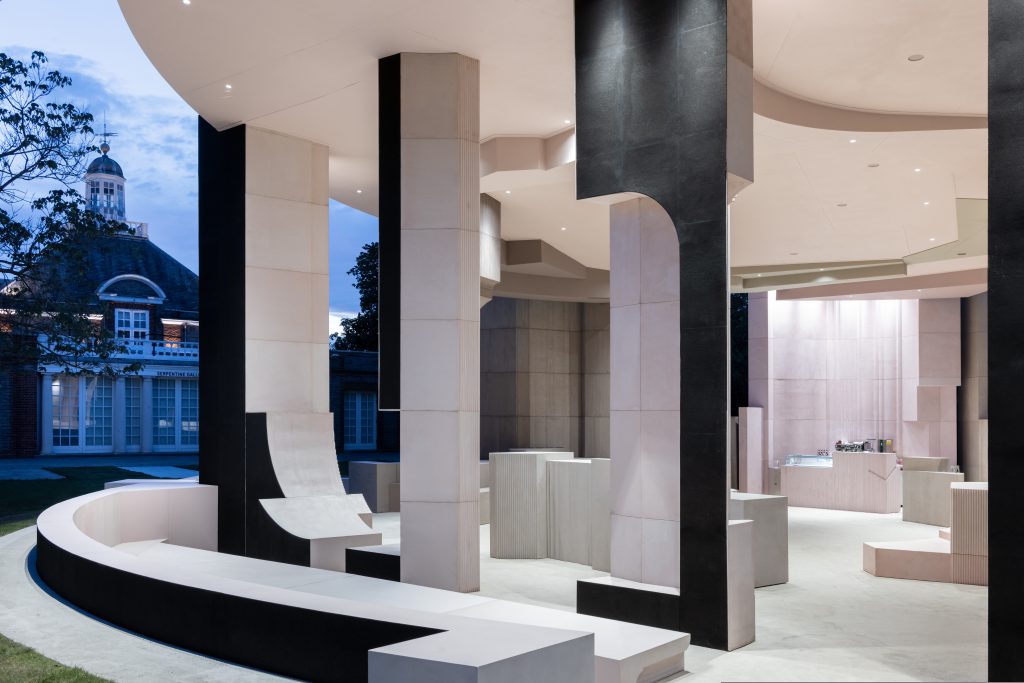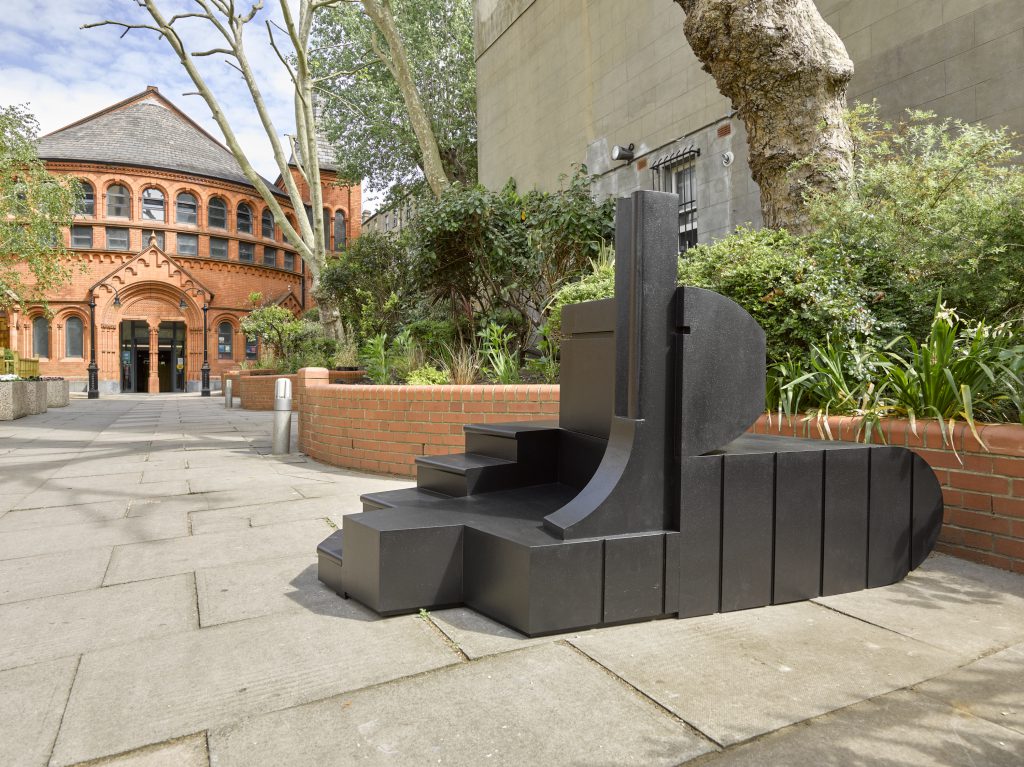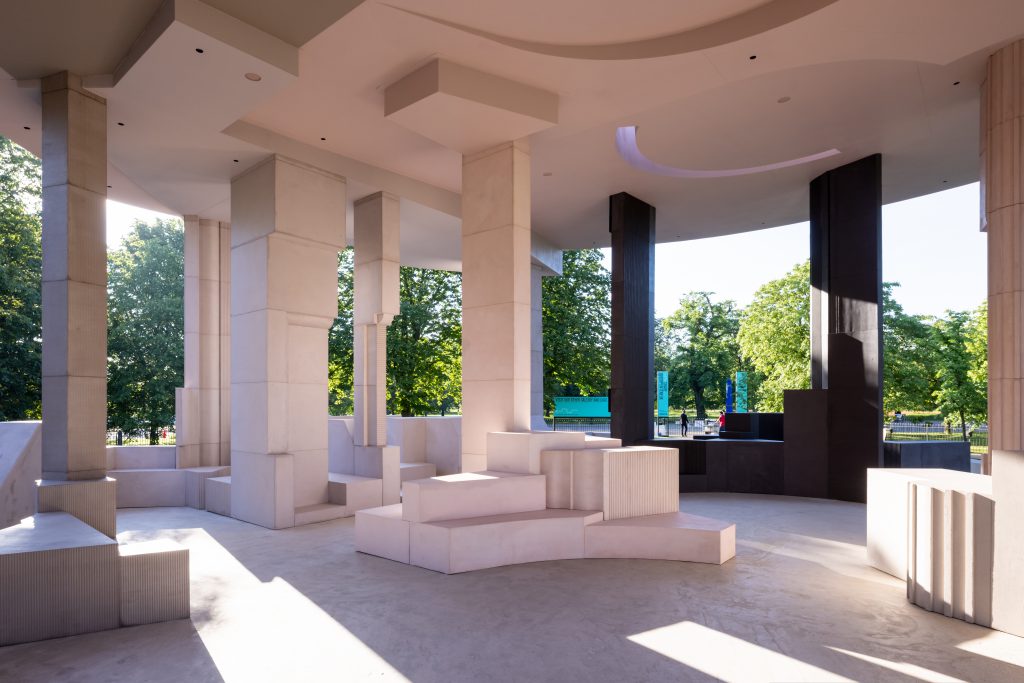I Want to Build Differently
Sumayya Vally
เป็นครั้งแรกในการทำงานของ Serpentine Gallery ที่เปิดตัว Serpentine Pavilion มากกว่าหนึ่งแห่งนอกเหนือจากอาคารหลักในสวน Kensington Gardens และเป็นครั้งแรกเช่นกันที่มีกลุ่มสถาปนิกหญิงอายุน้อยที่สุดเป็นผู้ออกแบบ โดยผู้ก่อตั้งสตูดิโอ Counter space จากเมืองโจฮันเนสเบิร์กในแอฟริกาใต้ Sumayya Vally เองยังเป็นสถาปนิกเพียงคนเดียวในรายชื่อ Time100 Next ที่ได้รับการยกย่องให้เป็นผู้นำแห่งการเปลี่ยนแปลงในอนาคตของปี 2021

ผลงานการออกแบบ Serpentine Pavilion ของ Counter Space นี้อาจเรียกได้ว่าสะท้อนแนวคิดจากมุมมองพหุนิยม (Pluralism) และให้ความสำคัญกับ “ความเป็นอื่น” โดยนำเสนอแนวคิดการออกแบบ Serpentine Pavilion ในฐานะพื้นที่เพื่อการพบปะของทุกคนที่นอกเหนือจากคนในแวดวงวิชาชีพ แต่พยายามสื่อถึงการมีตัวตนอยู่ของชุมชนคนพลัดถิ่น (Diaspora Communities) จากเมืองอาณานิคมของอังกฤษเอง หรือผู้อพยพโยกย้ายเข้ามาตั้งถิ่นฐานในเมือง ไปพร้อมๆกับสถานะของผู้เป็นส่วนหนึ่งในการร่วมสร้างประวัติศาสตร์สังคมพหุวัฒนธรรมในลอนดอน ซึ่งนอกจากอาคารหลักในสวนแล้ว ความพิเศษของการออกแบบในปีนี้คือสถาปนิกและผู้จัดงานยังริเริ่มการกระจายวางงานออกแบบชิ้นย่อยอีก 4 ชิ้น ไปติดตั้งในพื้นที่พบปะสำคัญของย่านชุมชนชายขอบในลอนดอนและองค์กรภาคีเครือข่าย โดยที่ชิ้นส่วนผลงานทั้งหมดสามารถนำมาประกอบร่างรวมกันได้ในภายหลัง

ส่วนของอาคารหลักสื่อถึงการประกอบร่างจากชิ้นส่วนอาคารที่พิมพ์แบบมาจากส่วนต่างๆของพื้นที่พบปะของชุมชนในรูปแบบต่างๆทั่วลอนดอน ทั้งสุเหร่า Fazl Mosque และ East London Mosque ร้านหนังสือชุมชน Centerprise ใน Hackney ร้านอาหาร The Mangrove และ Notting Hill Carnival หรือ The Four Aces Club ที่ Dalston Lane การรวมตัวจากองค์ประกอบหลายชิ้นส่วนทำให้เกิดมุมและพื้นที่นั่งในรูปแบบต่างๆหลากหลายที่เชื่อมต่อกันเกิดเป็นพื้นผิวที่ต่อเนื่องไปตลอดทั้งหลังของอาคาร ในขณะที่แต่ละชิ้นส่วนมีความโดดเด่นของตัวเองด้วยความแตกต่างของเรื่องราวที่มา องค์ประกอบ สี หรือวัสดุ จากทั้งเหล็กและแผ่นคอร์กที่นำกลับมาใช้ใหม่ หรือก้อนอิฐจากวัสดุธรรมชาติ แต่เมื่อมาอยู่ร่วมกันนั้นกลับเป็นส่วนเสริมของกันและกันภายในขอบเขตพื้นที่วงกลมใต้ระนาบหลังคาผืนเดียวกัน

จากการทำงานในช่วงที่โควิด-19 ระบาดอย่างหนักในลอนดอนนั้น ส่งผลให้ต้องเลื่อนเวลาการเปิดให้เข้าชมอย่างเป็นทางการมาเป็นช่วงมิถุนายนถึงตุลาคมของปี 2021 นี้ ในช่วงที่ผ่านมาจึงเป็นโอกาสที่สถาปนิกได้ทำงานศึกษาวิจัยในลอนดอนตามสถานที่ต่างๆ รวมทั้งร่วมกิจกรรมกับกลุ่มชุมชน และการค้นพบสถานที่ที่ถูกลืมเลือน สำหรับ Sumayya Vally นั้นแม้จะแทบไม่มีผลงานการสร้างจริง แต่สตูดิโอค่อนข้างเน้นการทำงานวิจัยออกแบบร่วมกับศิลปิน กลุ่มนักแสดง จัดกิจกรรมสร้างสรรค์ที่บอกเล่าเรื่องราวทางประวัติศาสตร์ในมุมที่ไม่เคยถูกถ่ายทอดมาก่อน โดยเฉพาะเรื่องราวน่าสะเทือนใจของกลุ่มแรงงานเหมืองผิดกฎหมายหรือกลุ่มคนงานที่ต้องหลบซ่อนตัวในช่วงยุคการแบ่งแยกเชื้อชาติของแอฟริกาใต้ (Apartheid era) ที่ถูกนำมาเล่าเพียงผิวเผินและไม่เคยมีการเยียวยาอย่างจริงจัง การศึกษาค้นคว้าทางประวัติศาสตร์และโบราณคดี ผ่านงานสถาปัตยกรรมไม่ว่าจะในเมืองโจฮันเนสเบิร์กหรือลอนดอนเอง แล้วถ่ายทอดออกมาในมุมอื่นๆนอกเหนือจากประวัติศาสตร์กระแสหลักของ Counter Space จึงมีความน่าสนใจในรูปแบบของ “การสร้างที่แตกต่าง” อย่างที่ผู้ออกแบบตั้งใจ

For the first time since the Serpentine Gallery began its operations, the Serpentine Pavilion Initiative that the commission has extended to the other areas of the city outside the Kensington Gardens. Another first to be celebrated is that the pavilion was designed by the youngest female architect Sumayya Vally who leads the Johannesburg practice- Counterspace. Vally is the only architect who has been selected in TIME100 Next List honoree of the leaders who are shaping the future in 2021.
Counterspace’s Serpentine Pavilion design could be described as a reflection of “Pluralism” with a focus on “Otherness” by designing the Pavilion as a “gathering space” for all apart from the professionals. It is also importantly trying to convey the existence of the diaspora communities from the colony itself or immigrants migrating to settle in the city along with the status of the participants who are co-creating a history of a multicultural society in London. Besides the main pavilion building in the garden, what is special this year is that the commission extends to the other areas of city, as four fragments of the Pavilion are installed in key gathering spaces in marginalized London neighborhoods and partner organizations, all of which can be assembled together later.

The main Pavilion represents the construction of abstract elements and details moulded from various parts of the community gathering spaces across London. This includes the Fazl Mosque and the East London Mosque, the Centerprise Community Bookstore in Hackney, The Mangrove Restaurant and Notting Hill Carnival as well as The Four Aces Club at Dalston Lane. The combination of various elements creates a variety of different angles and seating areas that connect to form a continuous surface throughout the building. While each piece is distinct with its origin story, composition, color or material from both reclaimed steel and cork sheets or eco-bricks from natural materials, when they come together they are complementary to each other within the circular space under one roof.
A delay of the official opening to June- October this year is due to the fact that COVID-19 hit London heavily during the working process. But it was a good opportunity for Vally to conduct research in London at various locations as well as participating in activities with community groups and discovering forgotten places. As for Sumayya Vally, she is the founder who directs Counterspace, the studio with hardly any built work. Much of their work emerges from research and interdisciplinary art-based creatives, undertaking predominantly creative projects that unfold historical stories in a never-before-seen angle. One of these are the heartbreaking tales of illegal miners, and workers hiding themselves during South Africa’s Apartheid era, the story which was superficially told and has never been seriously addressed.
What is truly interesting about Counterspace is that the studio has conducted historical and archeological studies through architecture, whether in Johannesburg or London, and then represented it in different perspectives other than what is found in mainstream history. It is a form of “to build differently” as the architect intended.

